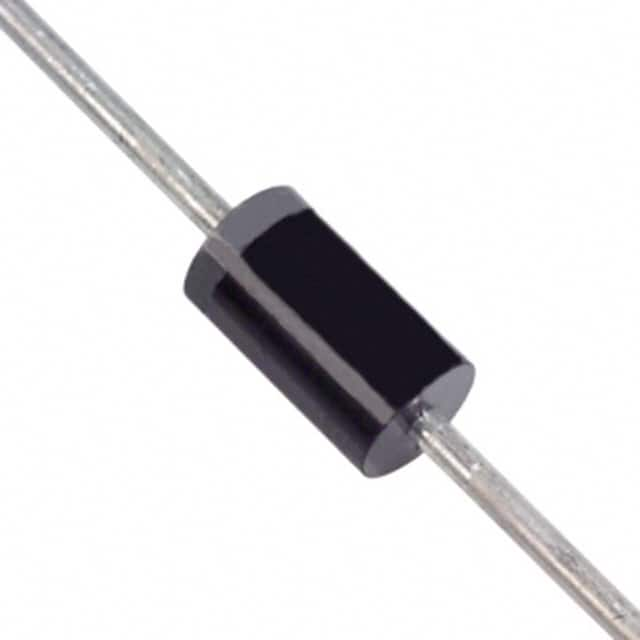Viz Specifikace pro podrobnosti o produktu.

1N5818-B Diode
Product Overview
The 1N5818-B diode belongs to the category of Schottky diodes. It is commonly used in electronic circuits for its low forward voltage drop and fast switching capabilities. The diode is characterized by its high current capability, low power loss, and compact package. It is typically available in a variety of packages such as DO-41, SMA, and SMB. The essence of the 1N5818-B diode lies in its ability to efficiently rectify and switch electronic signals. It is usually packaged in reels or tubes, with quantities varying based on manufacturer specifications.
Specifications
- Forward Voltage Drop: 0.45V at 1A
- Reverse Voltage: 30V
- Maximum Continuous Current: 1A
- Package Type: DO-41, SMA, SMB
- Operating Temperature Range: -65°C to +125°C
Pin Configuration
The 1N5818-B diode typically has two pins, anode and cathode. In the DO-41 package, the anode is denoted by a longer lead, while in SMA and SMB packages, the anode is typically marked with a line.
Functional Features
The 1N5818-B diode offers fast switching speed, low forward voltage drop, and high current capability. These features make it suitable for applications requiring efficient rectification and switching of electronic signals.
Advantages and Disadvantages
Advantages
- Low forward voltage drop
- Fast switching speed
- High current capability
Disadvantages
- Limited reverse voltage rating compared to other diodes
- Sensitive to temperature variations
Working Principles
The 1N5818-B diode operates based on the Schottky barrier principle, where the metal-semiconductor junction allows for faster switching and lower forward voltage drop compared to conventional PN-junction diodes.
Application Field Plans
The 1N5818-B diode finds extensive use in various applications including: - Power supplies - Voltage clamping - Reverse polarity protection - Switching regulators - DC-DC converters
Alternative Models
Some alternative models to the 1N5818-B diode include: - 1N5817 - 1N5819 - SS12 - SS14
In conclusion, the 1N5818-B diode is a versatile component widely used in electronic circuits due to its fast switching speed, low forward voltage drop, and high current capability. Its applications range from power supplies to voltage clamping, making it an essential component in modern electronics.
[Word Count: 337]
Seznam 10 běžných otázek a odpovědí souvisejících s aplikací 1N5818-B v technických řešeních
What is the 1N5818-B diode used for?
- The 1N5818-B diode is commonly used in applications requiring low voltage drop and high current capability, such as power supplies and voltage regulation circuits.
What are the key specifications of the 1N5818-B diode?
- The 1N5818-B diode has a maximum forward voltage drop of 0.45V at 1A, a maximum reverse voltage of 30V, and a maximum forward current of 1A.
How does the 1N5818-B diode compare to other diodes in its class?
- The 1N5818-B diode offers lower forward voltage drop and higher current capability compared to standard silicon diodes, making it suitable for high-efficiency applications.
Can the 1N5818-B diode be used for reverse polarity protection?
- Yes, the 1N5818-B diode can be used for reverse polarity protection due to its low reverse voltage and fast switching characteristics.
What are the typical applications of the 1N5818-B diode?
- Typical applications include DC-DC converters, battery charging circuits, voltage clamping, and low voltage rectification.
What are the thermal considerations when using the 1N5818-B diode?
- The 1N5818-B diode has a low thermal resistance and can handle moderate power dissipation, but proper heat sinking may be required in high-power applications.
Is the 1N5818-B diode suitable for high-frequency applications?
- The 1N5818-B diode has a fast recovery time and is suitable for moderate high-frequency applications, but specialized high-speed diodes may be preferred for very high frequencies.
What are the potential failure modes of the 1N5818-B diode?
- Common failure modes include overcurrent damage, reverse voltage breakdown, and thermal overstress, so proper circuit protection and derating should be considered.
Can the 1N5818-B diode be used in automotive applications?
- Yes, the 1N5818-B diode is suitable for automotive applications where low forward voltage drop and high current capability are required.
Are there any recommended layout or mounting considerations for the 1N5818-B diode?
- It is recommended to minimize lead length, provide adequate thermal relief, and ensure proper PCB layout to optimize performance and reliability of the 1N5818-B diode.

